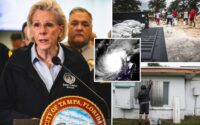West-central Florida braces for Hurricane Milton —potentially the region’s worst storm in 100 years
TAMPA, Fla. – Less than two weeks after Hurricane Helene struck Florida’s Big Bend, Milton is threatening to do the same, but given the state’s distinctive coastline, the angle of landfall could allow the new storm system to be the worst in over 100 years for parts of west-central Florida.
The area is certainly storm-weary, having recently experienced impacts from Helene, Debby, Ian and Idalia.
However, the FOX Forecast Center warns that the unique angle of approach makes the situation similar to what emergency managers have dreaded but prepared for over decades.
During Helene, communities south of Florida’s Big Bend experienced a storm surge of 5-8 feet on average, which was on the lower side of the spectrum due to the wind direction and the distance from the core of the Category 4 hurricane.
A track that sends a hurricane over or just to the north of the Tampa-Sarasota metro means significantly more water will be piled up compared to previous cyclones.
“The West Coast of Florida is spectacularly vulnerable to storm surge, as we have seen. Even a tropical storm can push Gulf water to dangerous heights, let alone a strong hurricane. It’s critical that everybody in Central and South Florida stay well-informed since things are developing quickly,” said FOX Weather Hurricane Specialist Bryan Norcross.
During a Category 3 hurricane, a storm surge model known as SLOSH, shows wide areas of Hillsborough, Pinellas and Pasco counties under feet of water.
Due to the topography of the shoreline, a water level rise of more than 9 feet can be expected if a major hurricane follows the worst-case scenario for the metro.
Trajectories significantly to the north or south of the metro lead to greatly altered outcomes, scenarios that some Floridians have experienced in recent years.
Hurricanes Idalia and Helene made landfall around 130 miles north of Tampa and produced storm surges on the order of 3-8 feet around the metro, due in part to the southerly flow.
On the flip side, Hurricane Ian in 2022 triggered a northeast flow over the region during its landfall near Fort Myers.
The hurricane’s winds actually caused a negative storm surge in Tampa Bay, with water levels receding by 5 to 8 feet.
Residents were even pictured walking along the muddy lakebed, though it was ill-advised.
Emergency managers have planned for worst case scenario for Tampa metro
While the exact effects of Milton won’t be known until the hurricane exits the Sunshine State, emergency managers have been preparing for a direct strike for years.
In 2009, the Tampa Bay Regional Planning Council developed a planning exercise it labeled “Project Phoenix,” which simulated the effects of a direct strike from a Category 5 hurricane.
The fictitious hurricane produced a storm surge of around 40 feet along the coast, and downtown Tampa saw a water rise of 10-15 feet.
The estimated cost of damage was in the hundreds of billions of dollars, which would make the event the costliest in US history, if it ever comes to fruition.
While no one, including the NHC and a vast array of computer models, is calling for Milton to reach Category 5 status, there is some historical precedent with a Category 3 cyclone that made landfall north of Tampa in 1921.
The 1921 Tampa Bay hurricane developed in the Caribbean and made landfall near Tarpon Springs as a Category 3 cyclone with winds around 120 mph.
According to the National Weather Service, a storm surge reached around 11 feet, and records indicated that only eight people lost their lives.
It is important to note that the estimated population in the Tampa Bay metro was just north of 100,000, compared to census estimates today that put the combined population at more than 3 million.
In over 180 years of record-keeping, Tampa has experienced only two direct hits by major hurricanes: the Category 3 cyclone in 1921 and a Category 4 in 1848.


